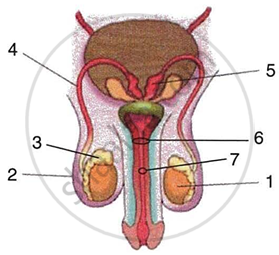Advertisements
Advertisements
प्रश्न
Write a note on human sperm
Describe the structure of human sperm.
उत्तर

Structure of Sperm
(Sperm = seed, zoon = animal)
It is a microscopic, elongated haploid motile male gamete or paternal gamete measuring about 0.055 mm (60 mu) in length. Sperm remains viable for seventy – two hours, but can fertilize the ovum in the first 12 to 14 hours only.
Human sperm is divisible into three parts - head, middle piece and tail.
- Head: It is a flat and oval region consisting of a large nucleus and an acrosome. Acrosome secretes hydrolytic enzymes like hyaluronidase which helps in the penetration of the egg during fertilization. The acrosome and anterior half of the nucleus are covered by a fibrillar sheath.
- Neck: It is a very short region having two centrioles. The proximal centriole plays a role in the first cleavage of the zygote. The distal centriole gives rise to the axial filament of the sperm.
- Middle piece: It serves as the powerhouse for sperm. It has many mitochondria spirally coiled (Nebenkern) around the axial filament. The mitochondria provide energy for the movement of the sperm in the female genital tract. The posterior half of the nucleus, neck, middle piece of sperm are covered by a sheath.
- Tail: The tail is a long, slender and tapering structure formed of cytoplasm. A fine thread, the axial filament arises from the distal centriole and traverses the middle piece and tail.
संबंधित प्रश्न
Explain the term Scrotum.
In humans, sperm production occurs in the organ ______.
How is the semen produced?
The increased level of estrogen and progesterone is responsible for menstruation.
Which of the following is a secondary sexual character observed in males?
Spot the odd one out from the following structures with reference to the male reproductive system.
Seminal plasma in human males is rich in ______.
Mark the odd one.
What is the significance of the testes being located in scrotal sacs outside the abdomen?
The figure given ahead is an organ system of humans. Study the same and answer the following questions.
 |
- Identify the organ system.
- Label the guidelines 1 to 7.
- Write one important role of parts 3 and 6.
- Name the cells of part 1 that produce testosterone.
- What is the significance of the part 1 being located in a separate sac suspended outside the body?
